Alexander the Great’s Tomb Found?
For months archaeologists have speculated about who lies within an ancient burial mound in northern Greece.
Now analysis of the skeleton discovered in an underground vault has revealed that the person who was buried there was male and was probably an important general.
He was of medium height with pale skin and brown or red hair, they said, suggesting that the remains could could well belong to blue-eyed king.
Alexander the Great was reputed to have had blue eyes and golden or red hair.
Further examination of the remains are expected to confirm that the man originated in the Thrace region in north east Greece, according to The Greek Reporter.
One contemporaneous account says his hair was ‘xanth’ - meaning ‘golden’ or ‘auburn’ - and a mosaic at Pella shows the warrior king with red hair.
However, other Roman writers said it was dark blonde, such as Roman rhetoric teacher Aelian, who wrote: ‘…his hair curled naturally and was yellow’.
Another expert said that the bones will reveal details about the man’s health and his diet.
Katerina Peristeri, head of the Amphipolis Tomb excavation believes that the man was an important general, although because robbers have removed valuable items in antiquity, no weapons or precious objects remain in situ.
But experts have hypothesised about how the grave would have looked at the time of burial.
Alexander the Great
Some commentators sill hold out hope that the skeleton belongs to Alexander the Great himself, based on the warrior king’s symbol being found inside the tomb.
However, The Greek Culture Ministry hasn’t mentioned the symbol or the chances of the bones being the legendary warrior’s.
Alexander died in Babylonia, present day Iraq, but his burial site remains unknown.
Some written accounts of the ancient leader’s appearance say that he had red, or strawberry blonde hair, raising hopes that the skeleton may be his.
One contemporaneous account says his hair was ‘xanth’ which means golden or auburn and a mosaic at Pella shows the warrior king with red hair.
However, other Roman writers said it was dark blonde, such as Roman rhetoric teacher Aelian, who wrote: ‘…his hair curled naturally and was yellow’.
Experts will analyse the bones and attempt to see if DNA of the man matches that of the Phillip II, Alexander the Great’s father. However, this may be difficult because the king’s DNA is said to be ‘overworked’.
There is conjecture on Twitter about whether a 1999 geological survey indicates there are many more burial chambers in the grand complex, perhaps hiding more remains, meaning that even if the remains do not belong to Alexander the Great, the legendary leader may still lie in the mound.
A new study of Kasta Hill is said to be under way to determine if experts have revealed all the site’s secrets.
Chrysoula Paliadeli, Professor of Classical Archaeology at the Aristotelian University of Thessaloniki, said: ‘Thanks to the elements we [have obtained] from other Macedonian graves, in which there was no human intervention after the burial, we can assume that we would have found armaments - a shield, sword, chest armour, helmet, shin guards and other items - and ceremonial containers made of gold or copper, chaplet and probably earthenware pottery.’
Further tests will determine whether the man was a member of the ancient royal family of Macedonia.
Lina Mendoni, Secretary Culture Secretary, warned it will be hard to determine this and such an investigation could take around eight months.
Scientists will compare the DNA of the bones to that of Phillip II, who was buried at Vergina, but this will be difficult because the genetic material is ‘overworked,’ she told Iefimerida.
The bones of Phillip II - father of Alexander the Great - were burnt and because DNA tests were carried out some 50 years ago, it is feared the results may have been contaminated.
There is much conjecture on Twitter as to whether the tomb might belong to Alexander the Great or whether it is a massive complex, of which only one chamber has been discovered.
Some Twitter users have spotted a symbol in the tomb that they say is the mark of the ancient leader, while others are pointing to the results of an old geological survey that hints the mound hides many underground stone structures.
Last week, Greece’s Ministry of Culture revealed that the body had been placed in a wooden coffin, which disintegrated over time.
The skeletal remains were found both inside and outside the rectangular stone-lined cist, under the floor of the cavernous, vaulted structure that is 26 feet (eight metres) tall
Iron and bronze nails as well as carved bone and glass decorations from the coffin were also found scattered in the grave.

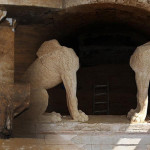
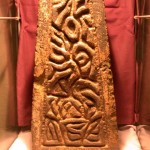
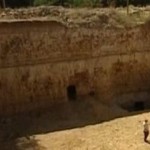
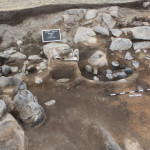
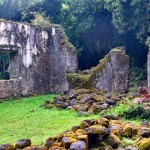

Pingback: New 3D Images of Amphipolis Tomb in Greece - Proxy Ponder()